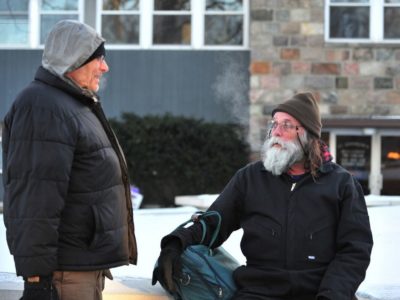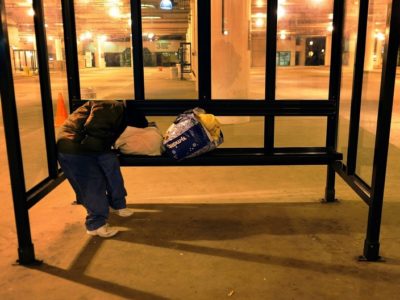
Seeing Dasani Coates standing alongside the dignitaries at Mayor Bill de Blasio’s inauguration earlier this month was a heartening sign. In December, the 12-year-old girl’s struggles living with her family in a decrepit city shelter had been vividly captured in this newspaper in Andrea Elliott’s series “Invisible Child.” Dasani’s story struck a chord. More than 2,200 readers commented online, expressing sentiments that ranged from admiration for her grit to outrage at the Dickensian circumstances in which she lived. De Blasio had laid out an aggressive agenda to help the city’s most vulnerable residents, promising to expand affordable housing and revive rental-assistance programs for homeless families. Here was a gesture to suggest he was serious.
As Elliott reported, the population in New York’s shelters has soared. In 2002, Mayor Michael R. Bloomberg (also) entered office with an aggressive plan to combat homelessness. However, during his tenure the number of homeless families in the city increased by 80 percent, with the nightly shelter population peaking at more than 53,000 this past November, up from 31,000 12 years ago (pdf).
Dasani’s story continued to come up in conversations for weeks after it was published. Almost everyone I spoke with had the same response. They found it heartbreaking — and they wanted to know what could be done.
The question is particularly timely, not just because we have a new mayor, but because we have new, and better, methods to reduce homelessness. In the past few years, cities across the country have made fundamental changes in the way they’re responding to the problem — both for chronically homeless individuals, including veterans, and homeless families.
Cities are moving away from long-term shelter and focusing, instead, on developing better ways to identify and prioritize vulnerable individuals and families, prevent crises, and rapidly re-house people, using short- or long-term assistance as needed.
The evidence is mounting that this works. Cities like Jacksonville, Fla., Nashville and New Orleans have made big strides providing permanent supportive housing to chronically homeless individuals. Recently, the White House declared that Phoenix had become the first city in the nation to eradicate chronic homelessness among veterans.
Other places, including Columbus, Ohio, Mercer County, N.J, Memphis and Grand Rapids, Mich., have figured out how to improve coordination across their systems to provide families with the right mix and dosage of services to get them into stable housing — without over-prescribing long-term transitional housing (pdf). This makes it possible to assist more people.
The big change came in 2009, when the Obama administration allocated $1.5 billion in the Recovery Act for the Homelessness Prevention and Rapid Re-housing Program, to prevent increases in homelessness during the recession. From 2009 to 2011, the program was credited with helping a million people avert homelessness or get re-housed. More than 80 percent remained in stable housing after two years (pdf).
Amid these changes, New York City has remained an outlier — in some areas, an innovator, in others, a laggard. The city’s homelessness prevention program, Homebase, the largest of its kind in the nation, served as a model for the federal initiative. This July, an evaluation (pdf) reported that the program reduced the proportion of families entering shelter from 14.5 percent to 8 percent. Surprisingly, Homebase-served families who entered shelter exited much sooner, too – staying, on average, 120 nights as opposed to 233 nights for the control group. With better targeting, experts believe the program could have significantly more impact.
Homelessness is an extremely adverse childhood experience. “If you factor in the reduction of childhood trauma, the savings to society in the long run from prevention is considerable,” commented Stephen Metraux, associate professor of health policy and public health at University of the Sciences, who worked on the Homebase study.
But the city has lagged behind the nation when it comes to acting rapidly to get families out of shelters and providing them with the help they need to remain stable in their own housing (this requires more than short-term rental subsidies). Over the past four years, the average shelter stay for families in the city has increased from about 250 days to over 400. (The federal government’s standard is that shelter stays should be limited to 30 days.)
There’s no solution to homelessness without building or preserving more affordable housing and simultaneously attacking poverty. This isn’t a problem unique to New York City. In 2011, some 8.5 million low-income families across the country were paying more than half their income on housing, a severe cost burden (pdf).
However, the city could make significant advances in the near-term if it improves the way it assesses families and matches them with services, as other cities have done. Homeless families are not all alike. Nationally, some 70 to 80 percent of families escape homelessness within three to six months and do not return to shelters. The rapid re-housing approach has shown that these families primarily need help finding housing, short-term rental subsidies and job assistance (pdf).
But some families experience recurrent episodes of homelessness; they need considerably more help – and they should be prioritized just like medical emergencies. These families are not representative of the city’s shelter population. It’s estimated that only 5 to 8 percent of homeless families are “multi-system-involved” like Dasani’s — contending with a variety of problems such as substance abuse, foster care, depression, disabilities and so forth.
For them, homelessness is a symptom of deeper problems. What was painfully obvious in the “Invisible Child” series was simply that Dasani’s family, with all its needs, should never have ended up in a shelter, let alone the Auburn Family Residence. “What is wrong with the picture of the most troubled multi-system involved families, with children with disabilities, being sheltered in the worst run facility for years?” asks Rosanne Haggerty, president of Community Solutions, which has initiated a range of efforts to combat homelessness, including the 100,000 Homes Campaign. “They should have gotten the highest quality help, in the most stable place. How are we matching resources?”


